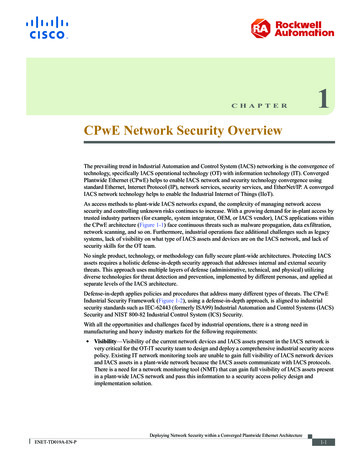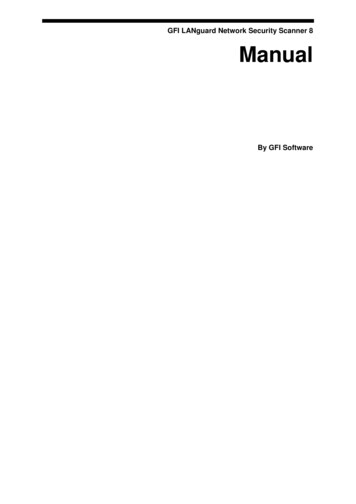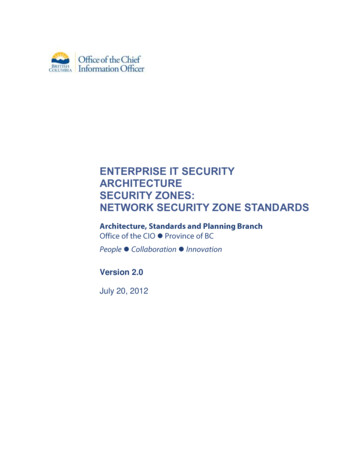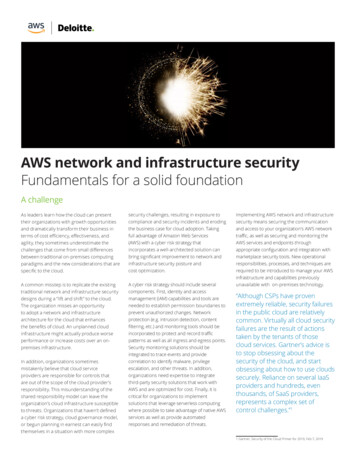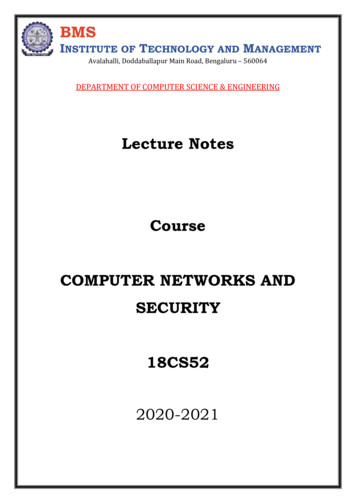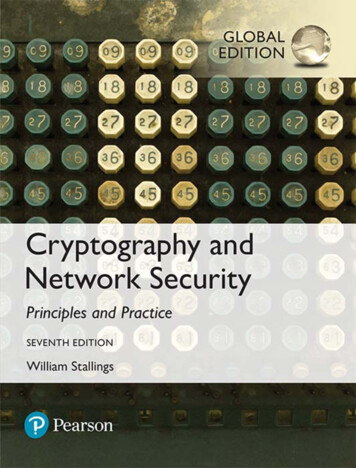
Transcription
Network SecurityAbout the TutorialNetwork Security deals with all aspects related to the protection of the sensitiveinformation assets existing on the network. It covers various mechanisms developed toprovide fundamental security services for data communication.This tutorial introduces you to several types of network vulnerabilities and attacks followedby the description of security measures employed against them. It describes thefunctioning of most common security protocols employed at different networking layersright from application to data link layer. After going through this tutorial, you will findyourself at an intermediate level of knowledge regarding network security.AudienceThis tutorial is prepared for beginners to help them understand the basics of networksecurity. The ones who are keen on taking up career in the field of Information andNetwork security, this tutorial is extremely useful. For all other readers, this tutorial is agood learning material.PrerequisitesWe assume the reader has a basic understanding of computer networking andcryptography. Knowledge about communication protocols is a plus.Disclaimer & Copyright Copyright 2018 by Tutorials Point (I) Pvt. Ltd.All the content and graphics published in this e-book are the property of Tutorials Point (I)Pvt. Ltd. The user of this e-book is prohibited to reuse, retain, copy, distribute or republishany contents or a part of contents of this e-book in any manner without written consentof the publisher.We strive to update the contents of our website and tutorials as timely and as precisely aspossible, however, the contents may contain inaccuracies or errors. Tutorials Point (I) Pvt.Ltd. provides no guarantee regarding the accuracy, timeliness or completeness of ourwebsite or its contents including this tutorial. If you discover any errors on our website orin this tutorial, please notify us at contact@tutorialspoint.com.i
Network SecurityTable of ContentsAbout the Tutorial . iAudience . iPrerequisites . iDisclaimer & Copyright. iTable of Contents . ii1.NETWORK SECURITY — OVERVIEW . 1Physical Network . 1Network Protocol . 2Goals of Network Security . 6Achieving Network Security . 62.NETWORK SECURITY — APPLICATION LAYER SECURITY. 8E-mail Security . 8PGP . 13S / MIME . 15DNS Security . 16Summary . 183.NETWORK SECURITY — SECURITY IN TRANSPORT LAYER . 19Need for Transport Layer Security . 19Secure Socket Layer (SSL) . 20TLS Protocol . 27Secure Browsing - HTTPS . 28Secure Shell Protocol (SSH) . 30Benefits & Limitations . 32Summary . 32ii
Network Security4.NETWORK SECURITY — NETWORK LAYER SECURITY . 34Security in Network Layer . 34Overview of IPsec . 36IPsec Communication Modes . 37IPsec Protocols . 40Security Associations in IPsec . 44Summary . 475.NETWORK SECURITY — DATA LINK LAYER SECURITY . 48Security Concerns in Data Link Layer . 48Securing Ethernet LANs . 50Securing Spanning Tree Protocol . 52Securing Virtual LAN. 53Securing Wireless LAN . 55Summary . 576.NETWORK SECURITY — NETWORK ACCESS CONTROL . 58Securing Access to Network Devices . 58User Authentication and Authorization . 58Password Based Authentication . 59Centralized Authentication Methods . 59Access Control Lists . 607.NETWORK SECURITY — FIREWALLS . 61Types of Firewall . 61Stateless & Stateful Packet Filtering Firewall . 62Application Gateways . 63Circuit-Level Gateway . 65iii
Network SecurityFirewall Deployment with DMZ . 65Intrusion Detection / Prevention System . 67Types of IDS . 68Summary . 698.NETWORK SECURITY – CRITICAL NECESSITY . 70Role of Network in Business . 70Necessity for Network Security . 71iv
1. Network Security — OverviewNetwork SecurityIn this modern era, organizations greatly rely on computer networks to share informationthroughout the organization in an efficient and productive manner. Organizationalcomputer networks are now becoming large and ubiquitous. Assuming that each staffmember has a dedicated workstation, a large scale company would have few thousandsworkstations and many server on the network.It is likely that these workstations may not be centrally managed, nor would they haveperimeter protection. They may have a variety of operating systems, hardware, software,and protocols, with different level of cyber awareness among users. Now imagine, thesethousands of workstations on company network are directly connected to the Internet.This sort of unsecured network becomes a target for an attack which holds valuableinformation and displays vulnerabilities.In this chapter, we describe the major vulnerabilities of the network and significance ofnetwork security. In subsequent chapters, we will discuss the methods to achieve thesame.Physical NetworkA network is defined as two or more computing devices connected together for sharingresources efficiently. Further, connecting two or more networks together is known asinternetworking. Thus, the Internet is just an internetwork – a collection ofinterconnected networks.For setting up its internal network, an organization has various options. It can use a wirednetwork or a wireless network to connect all workstations. Nowadays, organizations aremostly using a combination of both wired and wireless networks.Wired & Wireless NetworksIn a wired network, devices are connected to each other using cables. Typically, wirednetworks are based on Ethernet protocol where devices are connected using theUnshielded Twisted Pair (UTP) cables to the different switches. These switches are furtherconnected to the network router for accessing the Internet.In wireless network, the device is connected to an access point through radiotransmissions. The access points are further connected through cables to switch/router forexternal network access.1
Network SecurityWireless networks have gained popularity due to the mobility offered by them. Mobiledevices need not be tied to a cable and can roam freely within the wireless network range.This ensures efficient information sharing and boosts productivity.Vulnerabilities & AttacksThe common vulnerability that exists in both wired and wireless networks is an“unauthorized access” to a network. An attacker can connect his device to a networkthough unsecure hub/switch port. In this regard, wireless network are considered lesssecure than wired network, because wireless network can be easily accessed without anyphysical connection.After accessing, an attacker can exploit this vulnerability to launch attacks such as: Sniffing the packet data to steal valuable information. Denial of service to legitimate users on a network by flooding the network mediumwith spurious packets. Spoofing physical identities (MAC) of legitimate hosts and then stealing data orfurther launching a ‘man-in-the-middle’ attack.Network ProtocolNetwork Protocol is a set of rules that govern communications between devices connectedon a network. They include mechanisms for making connections, as well as formattingrules for data packaging for messages sent and received.2
Network SecuritySeveral computer network protocols have been developed each designed for specificpurposes. The popular and widely used protocols are TCP/IP with associated higher- andlower-level protocols.TCP/IP ProtocolTransmission Control Protocol (TCP) and Internet Protocol (IP) are two distinctcomputer network protocols mostly used together. Due to their popularity and wideadoption, they are built in all operating systems of networked devices.IP corresponds to the Network layer (Layer 3) whereas TCP corresponds to the Transportlayer (Layer 4) in OSI. TCP/IP applies to network communications where the TCP transportis used to deliver data across IP networks.TCP/IP protocols are commonly used with other protocols such as HTTP, FTP, SSH atapplication layer and Ethernet at the data link/physical layer.TCP/IP protocol suite was created in 1980 as an internetworking solution with very littleconcern for security aspects.It was developed for a communication in the limited trusted network. However, over aperiod, this protocol became the de-facto standard for the unsecured Internetcommunication.Some of the common security vulnerabilities of TCP/IP protocol suits are: HTTP is an application layer protocol in TCP/IP suite used for transfer files thatmake up the web pages from the web servers. These transfers are done in plain3
Network Securitytext and an intruder can easily read the data packets exchanged between the serverand a client. Another HTTP vulnerability is a weak authentication between the client and the webserver during the initializing of the session. This vulnerability can lead to a sessionhijacking attack where the attacker steals an HTTP session of the legitimate user. TCP protocol vulnerability is three-way handshake for connection establishment.An attacker can launch a denial of service attack “SYN-flooding” to exploit thisvulnerability. He establishes lot of half-opened sessions by not completinghandshake. This leads to server overloading and eventually a crash. IP layer is susceptible to many vulnerabilities. Through an IP protocol headermodification, an attacker can launch an IP spoofing attack.Apart from the above-mentioned, many other security vulnerabilities exist in the TCP/IPProtocol family in design as well in its implementation.Incidentally, in TCP/IP based network communication, if one layer is hacked, the otherlayers do not become aware of the hack and the entire communication gets compromised.Hence, there is need to employ security controls at each layer to ensure foolproof security.DNS ProtocolDomain Name System (DNS) is used to resolve host domain names to IP addresses.Network users depend on DNS functionality mainly during browsing the Internet by typinga URL in the web browser.In an attack on DNS, an attacker’s aim is to modify a legitimate DNS record so that it getsresolved to an incorrect IP address. It can direct all traffic for that IP to the wrongcomputer. An attacker can either exploit DNS protocol vulnerability or compromise theDNS server for materializing an attack.DNS cache poisoning is an attack exploiting a vulnerability found in the DNS protocol.An attacker may poison the cache by forging a response to a recursive DNS query sent bya resolver to an authoritative server. Once, the cache of DNS resolver is poisoned, thehost will get directed to a malicious website and may compromise credential informationby communication to this site.4
Network SecurityICMP ProtocolInternet Control Management Protocol (ICMP) is a basic network managementprotocol of the TCP/IP networks. It is used to send error and control messages regardingthe status of networked devices.ICMP is an integral part of the IP network implementation and thus is present in verynetwork setup. ICMP has its own vulnerabilities and can be abused to launch an attack ona network.The common attacks that can occur on a network due to ICMP vulnerabilities are: ICMP allows an attacker to carry out network reconnaissance to determine networktopology and paths into the network. ICMP sweep involves discovering all host IPaddresses which are alive in the entire target’s network. Trace route is a popular ICMP utility that is used to map target networking bydescribing the path in real-time from the client to the remote host. An attacker can launch a denial of service attack using the ICMP vulnerability. Thisattack involves sending IPMP ping packets that exceeds 65,535 bytes to the targetdevice. The target computer fails to handle this packet properly and can cause theoperating system to crush.Other protocols such as ARP, DHCP, SMTP, etc. also have their vulnerabilities that can beexploited by the attacker to compromise the network security. We will discuss some ofthese vulnerabilities in later chapters.The least concern for the security aspect during design and implementation of protocolshas turned into a main cause of threats to the network security.5
Network SecurityGoals of Network SecurityAs discussed in earlier sections, there exists large number of vulnerabilities in the network.Thus, during transmission, data is highly vulnerable to attacks. An attacker can target thecommunication channel, obtain the data, and read the same or re-insert a false messageto achieve his nefarious aims.Network security is not only concerned about the security of the computers at each end ofthe communication chain; however, it aims to ensure that the entire network is secure.Network security entails protecting the usability, reliability, integrity, and safety of networkand data. Effective network security defeats a variety of threats from entering or spreadingon a network.The primary goal of network security are Confidentiality, Integrity, and Availability. Thesethree pillars of Network Security are often represented as CIA triangle. Confidentiality. The function of confidentiality is to protect precious business datafrom unauthorized persons. Confidentiality part of network security makes surethat the data is available only to the intended and authorized persons. Integrity. This goal means maintaining and assuring the accuracy and consistencyof data. The function of integrity is to make sure that the data is reliable and is notchanged by unauthorized persons. Availability. The function of availability in Network Security is to make sure thatthe data, network resources/services are continuously available to the legitimateusers, whenever they require it.Achieving Network SecurityEnsuring network security may appear to be very simple. The goals to be achieved seemsto be straightforward. But in reality, the mechanisms used to achieve these goals arehighly complex, and understanding them involves sound reasoning.International Telecommunication Union (ITU), in its recommendation on securityarchitecture X.800, has defined certain mechanisms to bring the standardization inmethods to achieve network security. Some of these mechanisms are: En-cipherment. This mechanism provides data confidentiality services bytransforming data into not-readable forms for the unauthorized persons. Thismechanism uses encryption-decryption algorithm with secret keys. Digital signatures. This mechanism is the electronic equivalent of ordinarysignatures in electronic data. It provides authenticity of the data. Access control. This mechanism is used to provide access control services. Thesemechanisms may use the identification and authentication of an entity to determineand enforce the access rights of the entity.Having developed and identified various security mechanisms for achieving networksecurity, it is essential to decide where to apply them; both physically (at what location)and logically (at what layer of an architecture such as TCP/IP).6
Network SecuritySecurity Mechanisms at Networking LayersSeveral security mechanisms have been developed in such a way that they can bedeveloped at a specific layer of the OSI network layer model. Security at Application Layer – Security measures used at this layer areapplication specific. Different types of application would need separate securitymeasures. In order to ensure application layer security, the applications need to bemodified.It is considered that designing a cryptographically sound application protocol is verydifficult and implementing it properly is even more challenging. Hence, applicationlayer security mechanisms for protecting network communications are preferred tobe only standards-based solutions that have been in use for some time.An example of application layer security protocol is Secure Multipurpose InternetMail Extensions (S/MIME), which is commonly used to encrypt e-mail messages.DNSSEC is another protocol at this layer used for secure exchange of DNS querymessages. Security at Transport Layer – Security measures at this layer can be used toprotect the data in a single communication session between two hosts. The mostcommon use for transport layer security protocols is protecting the HTTP and FTPsession traffic. The Transport Layer Security (TLS) and Secure Socket Layer (SSL)are the most common protocols used for this purpose. Network Layer – Security measures at this layer can be applied to all applications;thus, they are not application-specific. All network communications between twohosts or networks can be protected at this layer without modifying any application.In some environments, network layer security protocol such as Internet ProtocolSecurity (IPsec) provides a much better solution than transport or application layercontrols because of the difficulties in adding controls to individual applications.However, security protocols at this layer provides less communication flexibilitythat may be required by some applications.Incidentally, a security mechanism designed to operate at a higher layer cannot provideprotection for data at lower layers, because the lower layers perform functions of whichthe higher layers are not aware. Hence, it may be necessary to deploy multiple securitymechanisms for enhancing the network security.In the following chapters of the tutorial, we will discuss the security mechanisms employedat different layers of OSI networking architecture for achieving network security.7
2. Network Security — Application Layer SecurityNetwork SecurityVarious business services are now offered online though client-server applications. Themost popular forms are web application and e-mail. In both applications, the clientcommunicates to the designated server and obtains services.While using a service from any server application, the client and server exchange a lot ofinformation on the underlying intranet or Internet. We are aware of fact that theseinformation transactions are vulnerable to various attacks.Network security entails securing data against attacks while it is in transit on a network.To achieve this goal, many real-time security protocols have been designed. Such protocolneeds to provide at least the following primary objectives: The parties can negotiate interactively to authenticate each other. Establish a secret session key before exchanging information on network. Exchange the information in encrypted form.Interestingly, these protocols work at different layers of networking model. For example,S/MIME protocol works at Application layer, SSL protocol is developed to work at transportlayer, and IPsec protocol works at Network layer.In this chapter, we will discuss different processes for achieving security for e-mailcommunication and associated security protocols. The method for securing DNS is coveredsubsequently. In the later chapters, the protocols to achieve web security will be described.E-mail SecurityNowadays, e-mail has become very widely used network application. Let’s briefly discussthe e-mail infrastructure before proceeding to know about e-mail security protocols.E-mail InfrastructureThe simplest way of sending an e-mail would be sending a message directly from thesender’s machine to the recipient’s machine. In this case, it is essential for both themachines to be running on the network simultaneously. However, this setup is impracticalas users may occasionally connect their machines to the network.8
Network SecurityHence, the concept of setting up e-mail servers arrived. In this setup, the mail is sent toa mail server which is permanently available on the network. When the recipient’s machineconnects to the network, it reads the mail from the mail server.In general, the e-mail infrastructure consists of a mesh of mail servers, also termed asMessage Transfer Agents (MTAs) and client machines running an e-mail programcomprising of User Agent (UA) and local MTA.Typically, an e-mail message gets forwarded from its UA, goes through the mesh of MTAsand finally reaches the UA on the recipient’s machine.The protocols used for e-mail are as follows: Simple mail Transfer Protocol (SMTP) used for forwarding e-mail messages. Post Office Protocol (POP) and Internet Message Access Protocol (IMAP) are usedto retrieve the messages by recipient from the server.MIMEBasic Internet e-mail standard was written in 1982 and it describes the format of e-mailmessage exchanged on the Internet. It mainly supports e-mail message written as text inbasic Roman alphabet.By 1992, the need was felt to improve the same. Hence, an additional standardMultipurpose Internet Mail Extensions (MIME) was defined. It is a set of extensions to thebasic Internet E-mail standard. MIME provides an ability to send e-mail using charactersother than those of the basic Roman alphabet such as Cyrillic alphabet (used in Russian),the Greek alphabet, or even the ideographic characters of Chinese.Another need fulfilled by MIME is to send non-text contents, such as images or video clips.Due to this features, the MIME standard became widely adopted with SMTP for e-mailcommunication.9
Network SecurityEnd of ebook previewIf you liked what you saw Buy it from our store @ https://store.tutorialspoint.com10
Network Security 6 Goals of Network Security As discussed in earlier sections, there exists large number of vulnerabilities in the network. Thus, during transmission, data is highly vulnerable to attacks. An attacker can target the communication channel, obtain the data, and read the same or re-insert a false message to achieve his nefarious aims.File Size: 1010KB
